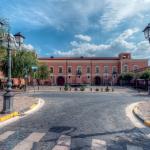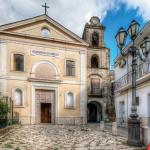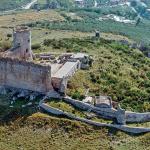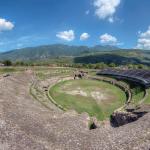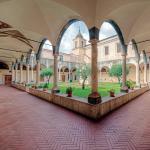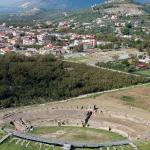The Municipality of Avella rises in the area of Lower Irpinia. It's a town with 7,688 inhabitants, located 207 metres above sea level, at 24 km from Avellino. The territory extends for 29.39 sq km and the adjoining municipalities are: Baiano, Casamarciano, Cervinara, Pannarano, Roccarainola, Rotondi, San Martino Valle Caudina, Sirignano, Sperone, Tufino and Visciano. It's crossed by the river Clanio.
There are several hypotheses on the etymology of the name: it seems to come from "abblona", a Latin term meaning 'rich in apples'; from "abel", meaning "grassy field"; while in the 18th century the botanist Linnaeus gave the scientific name to the hazelnut, nux avellana, relating to the species corylus avellana precisely from Avella. The inhabitants are called Avellani and their patron saint is Saint Sebastian.
PLACES OF INTEREST
- MIA Avella - Avella's Immersive and Archaeological Museum is a technological display set up in the Baronial Palace of Avella. It's a project included in the Sistema Irpinia's territorial enhancement plan. It's a multimedia route characterised by projections, graphic suggestions, talking pictures and Virtual Reality stations to tell the story of Avella and of the Palace
- Archaeological Area of the Roman Amphitheatre of Avella - This is the most important Roman architectural work in the town: an open-air museum in which it is possible to relive the glory of Imperial Rome
- Archaeological Area of the Monumental Necropolis of Avella - Among the most representative finds of tombs from the Roman period, the Avella necropolis offers a glimpse of Imperial Rome between the 1st century BC and the 1st century AD.
- Avella castle - A fairy-tale destination set amidst uncontaminated nature, the Castle is a place of cultural tourism, perfect also for walkers and explorers
- Archaeological Antiquarium of Avella - Houses vases, votive objects and funerary objects dating back to the first phases of settlement in the Lower Irpinia area, it houses vases, votive objects, funerary objects dating back to the first settlement phases of Lower Irpinia
- Baronial Palace Alvarez De Toledo - It's the Municipal seat, and it's an example of rare architectural beauty from the first half of the 16th century, with the adjoining garden "Livia Colonna", in Vanvitelli style, and a marble fountain
- Church of the SS. Annunziata - Religious building dating back to 1588, with an adjoining convent of Franciscan Friars Minor and a splendid internal cloister
- Collegiate Church of San Giovanni Battista - Also known as Parish Church of Santa Marina, it is distinguished by its imposing bell tower and 18th-century paintings
- Other Churches - Church of San Pietro Apostolo (Saint Peter the Apostle), Church of San Romano Martire (Saint Romanus the Martyr), Church of the Purgatory, Church of the Sette Preti (Seven Priests), Church of the Madonna delle Grazie (Our Lady of Graces), Church of San Ciro (Saint Cyrus), Chapel of Saint Candida, Church of Madonna del Carmine (Our Lady of Mount Carmel)
- Nature trails - Fusaro, Acqua Pendente Waterfalls, Saint Michael’s Cave
EVENTS
- Pane, Ammore e Tarantella (Bread, Love and Tarantella) - Art, culture, music and food and wine event
- Festival of the chestnut and hazelnut from Avella - Wine and food event linked to the main products of the territory
- Jazz at the Castle - Music event inside the ancient fortress
- Pomigliano Jazz - Important musical event in the ancient Roman amphitheatre of Avella
- Avella Art Festival - Festival with music and performances
- Music in the Park - jazz and blues festival that takes place in the Court of the Baronial Palace
- Theatre under the stars - festival with the most important theatre companies of Campania
TYPICAL FOOD AND PRODUCTS
- Hazelnut - The Avellana/Irpina hazelnut - nux avellana - with its strong historical, cultural and socio-economic link to its geographical area of origin, is a gastronomic excellence with a rich assortment of varieties: Mortarella, San Giovanni, with elongated fruit (more than two thirds of production), Tonda Bianca and Tonda Rossa di Avellino.
- Tagliatelle with walnut sauce and Fresh pasta with hazelnut pesto - First courses centred on the hazelnut, the main local product
- Zolfariello Bean PAT - Typical of the Mounts of Avella, with a light straw colour, with a characteristic sulphur note in the taste
- Baiano Bread PAT - this bread, with its elongated shape and elastic crumb, it has large, uneven holes and a thick, crispy crust
- Cassata avellana - Typical dessert of the area of Lower Irpinia, with hazelnut, ricotta and sponge cake
- Beans Pecoraresca style - Typical dish made with beans, oil, oregano, chilli and stale bread
- Orsino Garlic Pesto - A typical product cultivated at an altitude of 1,000 metres in the Avella mountains
- Capicollo PAT - A sausage made from a cut of meat taken from the back of the pig's neck, from which the name derives
- Caciocavallo Silano PDO - Semi-hard cheese, with spun curd, made from the milk of different breeds of cows, including Podolica
FUN FACTS
Avella's amphitheatre, built in tuff opus reticulatum in the 1st century BC, is older than the famous Colosseum in Rome, built in 72 AD..
HISTORICAL NOTES
The origins of Avella are very ancient: life, here, developed in the prehistoric age. When the territory was inhabited by the Osci, it extended between the mountains of Partenio and the plain of Palma Campania, in a fertile plain much larger than the present one. After the Etruscans, Avella became Samnite around the 5th century BC, a domination that lasted little more than a century; while, with the arrival of the Romans, in 399 BC, it became a Municipality.
During the long period of domination, Avella repeatedly deserved the Roman consideration due to its loyalty. Later, it was overrun by Vandals, Goths and Greeks who destroyed it, except for its extraordinary castle. After the Lombards and Saracens, peace came with the Normans and the return of the people of Avella to their former homes. This was the origin of the Barony of Avella, which also included the current Baiano and Cicciano.
The dynasty of the barons of Avella began with Arnaldo, nephew of Riccardo, Count of Avella and Prince of Capua, and then developed through Rinaldo III, knight of Charles of Anjou, the Orsini family, Filiberta di Chalou, Girolamo Colonna, Caterina Saracino and the Spinelli counts, who embellished Avella with streets and public buildings, restoring the Castle and the Baronial Palace to their former glory.
Autumn, with its many colours, is the ideal season to visit Avella and its cultural heritage. Walking through its streets, inflamed by its history, sparks a desire, which makes you become part of the town.
Avella
Piazza Municipio, 83021 Avella AV, Italia
Events
Sunday 12 May a unique experience with a guided tour of the ruins of the Avella Castle. The…
On Friday 11 October, local institutions and experts in the sector will present new…
-
Three unforgettable nights of art, popular music, travelling groups and food and wine in a…
-
This highly symbolic name encapsulates the essence of the event. A feast of culture, food and…
Featured places
Via Anfiteatro, 83021 Avella AV, Italia
It's an open-air museum celebrating the greatness of Avella in the Roman period where you can…
Piazza Municipio, 83021 Avella AV
Multimedia itinerary featuring projections, graphic suggestions, talking pictures, and Virtual…
Via Campopiano, 83021 Avella AV, Italia
A fairytale destination located among unspoiled nature, the Castle is a place of great…
Via Tombe Romane, 83021 Avella AV, Italia
The necropolis of Avella, among the most representative finds of burials from the Roman period…
Did you like it? Leave a review
Your opinion is important! It will be visible after approval by the editorial staff.
To post a comment you must be an authenticated user. Log in with Social Login
